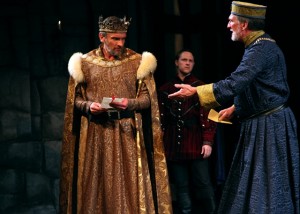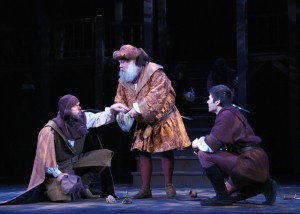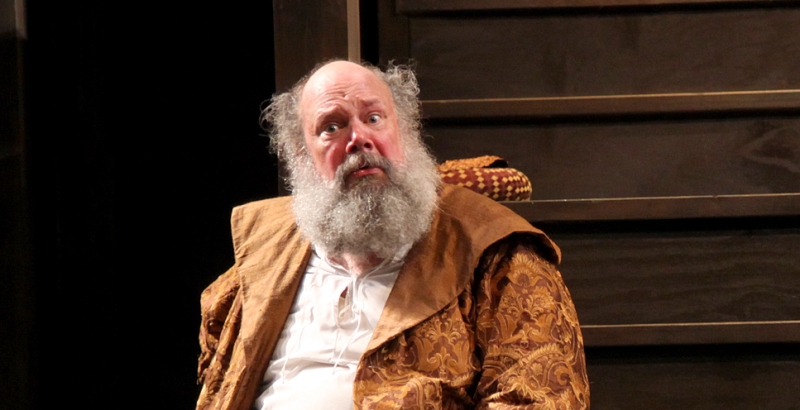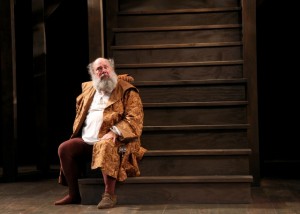
(l to r foreground) Brent Harris as King Henry the Forth and John Little as Earl of Westmoreland in Shakespeare Theatre of New Jersey's HENRY IV, PART ONE. (Photo: ©Gerry Goodstein)
HENRY IV, PART ONE is among Shakespeare’s finest plays. At once witty, moving, comic and suspenseful, and featuring in Prince Hal and Jack Falstaff two of the playwright’s greatest characters, it is perhaps the play containing the most of what we love about Shakespeare. It remains, however, too often under-appreciated and much too rarely performed. The Shakespeare Theatre of New Jersey bucks both of these trends as it opens its fiftieth anniversary season with a simply marvelous production of this monument of a play.
Despite its title, HENRY IV, PART ONE is much less concerned with the embattled king than it is with his son and heir apparent, Prince Hal. It is the second of four plays in Shakespeare’s Henriad, an epic that concludes in grand fashion with Henry V’s defeat of the French at Agincourt against impossible odds. Before he can become king and a great leader of men, however, Henry V must be Prince Hal, a young man who struggles to come to terms with his personal and political responsibilities as crown prince. This struggle is the story of HENRY IV, PART ONE, and we watch as Hal slowly, and perhaps begrudgingly, transitions from a “young, wanton and effeminate boy” in the bars and brothels of London’s slums into a stalwart prince at court.
The play begins as unrest grows in England. Having usurped the crown from his predecessor Richard II, King Henry now faces the threat of an uprising by his former allies who feel their support in helping Henry to the throne has been overlooked and disrespected. With war on the horizon, Henry sends for his son Hal to abandon his wantonness and return to court to support the throne. We thus meet Hal as his days of recklessness are drawing to a close, and he begins to distance himself from his lowly companions and his great professor of revelry, Sir John Falstaff. The play introduces us to Hal and Falstaff at the final stages of the prince’s apprenticeship in drink, lechery, mischief, and bombast, and so many of their shared scenes are dazzling pageants of rhetoric and hijinks as the proud master and confident pupil sling insults and poke fun of each other. Hal’s duty calling him out of the brothels and onto the battlefields casts doubt on the future of this relationship. The prince knows that will have to abandon the company of his great friend, but Falstaff is far less attuned to England’s political realities. HENRY IV, PART ONE thus traces the process of Hal transitioning away from Falstaff, rising to the challenge of his rival Hotspur, and seeking to demonstrate his nobility to the king his father. The prince’s road from the slums to the castle is of course far from smooth, littered as it must be with war, humility, and broken friendships.
HENRY IV, PART ONE runs on the fuel of its Falstaff and Hal, and The Shakespeare Theatre of New Jersey’s production ensures that those roles shine their brightest. Derek Wilson expertly locates Hal at the threshold of young adulthood, warily crossing into his life as a man. While reveling at the Boar’s Head Tavern of Eastcheap, Wilson’s Hal beams with a joy of life, elated to be party to this band of miscreants, and when responsibility calls him before the king, this Hal is cautious, tentative, and dutifully reverent. Hal cannot work if he is two different characters at Eastcheap and court, but Wilson nimbly avoids that pitfall: the thread of one young man navigating his way through the social demands of wildly different environments remains constant. Wilson gives Hal a sense of nobility in the barrooms and an undercurrent of wantonness at court and on the battlefield. Hal is a field researcher of human nature, and Wilson shows us the emerging results of that research at all times.
And then there’s Falstaff, King Henry’s worthy foil who holds court in Eastcheap with a purse-snatching dagger for scepter and booze-filled pewter mug for chalice. John Ahlin brings this character to marvelous life in a masterful performance that ought not be missed. Ahlin’s Falstaff brims with wit and humor when carousing, broods with a melancholy of old age in moments of reflection (and hangover), and best of all reveals a vulnerability and tenderness always attendant upon the knight’s bonhomie. Ahlin’s Falstaff is not some larger-than-life clown, but the all too human bacchanal, as prone to fear and self-doubt as the rest of us. This Falstaff is a comic delight when navigating his way as far from battlefield danger as possible, but he simultaneously arouses a deep pathos with his desperate efforts to cling to life. He is likewise grandiose and bombastic in his tutelage of Hal while making clear a paternal affection for his young friend. Those familiar with how this relationship ends in this play’s sequel are likely to be moved all the more by Ahlin’s performance, but even those who are not will recognize a powerful human spirit in this wonderful Falstaff.

(l to r) Patrick Toon as Bardolph, John Ahlin as Sir John Falstaff and Jordan Laroya as Peto count the coins they stole from unsuspecting pilgrams. (Photo: ©Gerry Goodstein)
The play’s best scenes are those between Falstaff and Hal, and director Joseph Discher deftly captures the characters’ playful repartee. In particular, he uses the famous scene in Eastcheap where Falstaff and Hal take turns impersonating the king to usher both through all the many facets of these complicated characters. Falstaff rises to heights of gaiety and nadirs of pity while Hal struggles outwardly with encroaching duty, and the moment between the two when Hal foreshadows banishing Falstaff of his company reverberates with poignancy as Discher freezes the two in a locked stare while the rest of the bar crowd flutters about in fear of the coming sheriff. Here and throughout the play, Discher’s directorial choices smartly underscore the play’s keys, while nicely moving it along at a brisk pace. Just before the final curtain, Discher will take one liberty to which purists might object, but it is an apt and appropriate reminder of the play’s most important tension: Hal’s active choice to leave his riots—and their conductor—behind.
While Fat Jack and Prince Hal deserve far more stagings than they get, it is important that their opportunities for the spotlights are capitalized upon to their fullest. This production does just that. Accenting its strong performances with beautifully sparse settings and well-choreographed battle scenes, The Shakespeare Theatre of New Jersey’s HENRY IV, PART ONE is a triumph. It locates the heart of one of Shakespeare’s truest masterpieces, and brings it out with sensitivity and skill.
HENRY IV, PART ONE
Written by William Shakespeare
Directed by Joseph Discher
May 30 – June 24, 2012
The Shakespeare Theatre of New Jersey
36 Madison Avenue
Madison NJ, 07940
973-408-5600
www.ShakespeareNJ.org



